
Outside of co-creating Dungeons & Dragons, the next biggest contribution Gygax may have made to fantasy gaming is Appendix N. I’m not going to defend Gygax’s taste in fantasy as being definitive by any means, but Appendix N introduced the concept of mapping your inspirational media. In my case, Appendix N introduced me to Fritz Leiber and the city of Lankhmar. More than about anything on the list, the Fafhrd and the Gray Mouser stories fired my imagination.
That means anytime I see a fantasy city with conspiracies, factions, ancient magical secrets, quirky rulers, and messed up laws, it’s going to catch my attention. I love Waterdeep, Camorr, Karnaca, Sigil, Doskvol, Avalon, and countless others because of the weirdness, wonders, and treachery that I encountered in Lankhmar.
Cities like this have been used for all kinds of RPGs with different focuses over the years. From dungeon crawling, level-based games, heist focused games, and games with gritty, exacting rules. When I heard that the Gumshoe system, which has its roots in mysteries and investigations, was going to be applied to the genre with Swords of the Serpentine, I knew I was going to be taking a closer look.
Disclaimer
I preordered Swords of the Serpentine when it was first announced, but Gnome Stew was offered a pre-publication review copy. While I own a number of Gumshoe games, including Trail of Cthulhu, Ashen Stars, Night’s Black Agents, and TimeWatch, I have never had the opportunity to play or run a Gumshoe game.
Safe Adventuring
At the beginning of the GM Advice section, there are a few paragraphs introducing the concept of the X-Card, with a note to search for RPG Safety and Calibration Tools online. While the game presents tropes like being mentally dominated by sorcery, in many cases, characters have the option to take morale damage if they don’t want to be controlled by someone else, giving players a bit more agency when it comes to their autonomy.
Because the genre can get violent and gruesome, and because various sections mention violence to animals and children, disease, and physical maladies, there are a few places where the text might get intense for those that have an aversion to those elements. Given some of the tropes included in the setting, I wish there were a little bit more room devoted to safety tools, especially when part of the safety discussion that is included is essentially search terms.
I also wanted to note that this book carries on a Pelgrane Press tradition. It uses “She/Her” pronouns for the Gamemaster, and while I get that this was much more inclusive when the practice started, “They/Them” really is my preferred way to go on this.
 City of the Serpentine
City of the Serpentine
This review is based on the PDF of Swords of the Serpentine, which is 396 pages long. This includes map endpapers, a title page, a credits page, a two-page list of play testers and advisors, an eight-page table of contents, seven pages of quick references, a character sheet, and a sheet for tracking factions, characters, and events in a campaign. The last ten pages of the book comprise the index for the book.
The pages have a watermarked rumpled parchment background, with headers and footers with decorative flourishes. The book has a two-page layout, with clear headers, sub headers, and sidebars. Each chapter is color coded, switching from browns, to greens, to purple, gold, and blue, depending on the section of the book. There are quarter and half page images throughout the book, along with full page images introducing different sections. Everything worked for me, from the layout to the colors, and it was extremely comfortable and pleasant to read through the book.
Layout and Structure
The book is organized into the following sections:
- Chapter One: The Basics
- Chapter Two: Your Hero (character creation)
- Chapter Three: Rules (core system resolution)
- Chapter Four: Sorcery and Corruption (examples of what sorcery can do and its consequences)
- Chapter Five: Wealth and Lifestyle (the abstracted wealth system and how lifestyle affects interactions)
- Chapter Six: Gear, Both Sorcerous and Mundane (modifiers for different weapons, description for different gear, and potentially dangerous magic items)
- Chapter Seven: Adversaries (example members of various factions and monstrous creatures)
- Chapter Eight: GM Advice (examining tropes of the genre, how to structure mysteries, and allow for player improvisation and shared world building)
- Chapter Nine: The City of Eversink (the districts and factions of the city, including ongoing plots and drives)
- Chapter Ten: The World (the nations that surround Eversink and how Eversink interacts with these nations, especially economically)
- Chapter Eleven: Corpse Astray (example adventure about family, betrayal, body snatching, and revenge)
The sidebars that appear throughout the game discuss the reasoning behind the various design decisions, as well as some of the changes made from the playtest version to the final product. These are very conversational segments that make designer intent clear. While some other Gumshoe games have similar sidebars, I think these are much more relaxed in tone. If you are familiar with the designer notes in 13th Age, these have a familiar feel to them.
 Gumshoe by Way of Swords and Sorcery
Gumshoe by Way of Swords and Sorcery
If you are familiar with the Gumshoe system, a lot of this will feel familiar. If you are familiar with TimeWatch, it’s really familiar. But there are some quirks unique to this version of the system. In general, here are the basics:
- You have a number of abilities. Your rank in these abilities is expressed as a pool of points you can spend
- If you have an investigative ability with any ranks, you gain a clue whenever you are in the right place at the right time, without rolling or spending anything
- You can spend points from your investigative pool to get extra context on clues, or to add narrative benefits to the scenario that are relevant to the ability
- If you make a check with general abilities, you can spend points from your pools to add to your roll, otherwise, you are rolling with a d6 against a difficulty number
- You have Health and Morale, and once these reach zero, you have difficulty functioning, with more difficulties the further into negative numbers you go
- The preparedness general ability allows you to roll to see if you have the right tool for the right job, without trying to plan for every eventuality up front
With this implementation of Gumshoe, there are a few more action-oriented modifications to the rules that come into play. Characters can spend investigative abilities to do more damage as they spot weaknesses or exhibit their knowledge of their opponent’s tactics. Characters that roll 5 or more over their opponent’s target number do more damage. Characters have armor and grit, which reduces damage taken to health or morale.
Different general abilities grant special additional benefits when they reach 8 or higher. For example, at 8 Athletics, a character can spend a point of the ability to attempt to dodge when attacked. A character that has 8 or more in Preparedness can spend pool points to set up a flashback where they did various beneficial actions in the past, off screen. When one of the combat focused abilities (Sorcery, Sway, and Warfare) reaches 8, they gain the ability to more easily affect multiple targets.
Just the Facts
Instead of rolling for different abilities, sometimes a character can propose that they spend X amount of one of their pools to declare that something happens. This must make sense for the pool being spent. For example, someone with Servility might say that they blend into a crowd and are unnoticed, instead of making a Stealth test. Someone with City’s Secrets might propose they spend X amount of their pool to find a shortcut to a location to arrive there before a rival band, instead of rolling the dice to race them.
In some cases, abilities can be used as alternate attack abilities if the GM is amenable to the description. For example, a character might use Wilderness Mastery to attack when in a forest and explain that they maneuvered their opponent across the path of poison spore mushrooms.
One of my favorite ways to utilize these pool spends comes from examples in Laws and Traditions, where a character can spend points from this pool to declare obscure laws that people have forgotten are on the books. I won’t go into too much detail, but this reminds me of the great “the police can’t arrest you at a waffle house until you have finished your meal” law that my group came up with in a Monster of the Week game.
Because all of these spends must be justified within the context of the pool from which the points are spent, Sorcery becomes very flexible in the game. While Sorcerers have a limited number of Spheres that they can use to help limit their power, it’s still wide open to do things like proposing spends that teleport or destroy walls that are in the way, for example.
 Magic!
Magic!
Sorcery is another way that Swords of the Serpentine diverges from other Gumshoe games. While there are some other supernatural abilities, like Spirit Sight or Prophesy, these are supernatural means of gathering or learning information, like other investigative abilities. Sorcery requires points of Corruption, and that means that Sorcery is never really a good thing, and at best is a necessary evil, and the character delves into the secrets of the ancient Serpentine empire for power, or forms a bond with demons or minor godlings to tap into their powers.
Sorcery is very flexible, and while it is a combat ability, it can also be used for a variety of other effects. Characters must determine if their sorcery does health or morale damage when they start down this path, although spending a point of corruption lets you flip your damage type. In addition to picking between health and morale for the damage type, sorcerers pick a sphere for each point of corruption they have, and their magic is flavored and narratively limited by the sphere. For example, someone with Demonology as a sphere is likely summoning fiends to attack others, or sending out imps to find information, while someone with Shadow as a sphere might strangle someone with their own shadow or listen or see through shadows to get their information.
Points of corruption can be used to do exceptional damage or to damage areas, create unique effects, curse others, and create glyphs and traps. When doing things like increasing area attack damage, Sorcery can easily damage allies. Spending corruption also means that the Sorcerer must choose between internalizing or externalizing corruption. Externalizing leaves a scar in the metaphysical plane that can be detected with Spirit Sight, and internalizing corruption forces you to roll to see if you have been physically changed by your magic in a way that is obvious to others. Externalizing corruption also harms specifically your allies, doing morale damage to them.
There are various tables that help to define the scope and range of magical effects, and how much those effects cost in corruption. In addition, if a Sorcerer dies, they can spend all their remaining corruption in a Death Curse, and treat this curse as if it had been cast using more corruption than the Sorcerer expended upon their death.
In the alternate rules section, there is also an alternative to corruption, which is Thaumaturgy. Sorcery remains a combat skill, but instead of spending corruption, the character spends Thaumaturgy points. Thaumaturgists don’t get to use curses or set wards. They still choose spheres, but those spheres are more “scientific” applications of magic, like alchemy, mesmerism, and poisoncraft. A Thaumaturgist may not wave their hand and make a wall disappear or blow up, but they can still stare into someone’s soul and do morale damage or fling an alchemically treated stone at a foe to cause a thunderclap to injure them.
Making Your Character
Players make characters by picking a profession (sentinel, sorcerer, thief, warrior, or custom), which creates a baseline of abilities. They add adjectives that describe the hero, as well as drives, framed as “What is Best in Life?” You gain a number of investigative build points based on the number of players in a game, and then gain additional general build points.
You then pick allegiances and enemies. These work like investigative abilities, and model calling in favors or remembering aspects related to a faction. Whenever using enemy points, however, enemies gain the ability to spend from their own pools to complicate your life.
Characters can have five or more pieces of minor, iconic gear that define your character. While these might be temporarily lost, you always end up with these items (or ones just like it) in your possession without needing to spend wealth or favors to get more.
In some Gumshoe games, part of character creation is making sure that the key investigative abilities are spread out amongst the players. Swords of the Serpentine is less worried about this, in part because of the heavy focus on action scenes in addition to investigation, and because the way investigative spends are presented tend to be broader and more improvisational.
Doing Stuff
In addition to investigative spends and general ability checks, in some cases, characters may just have a cost to narratively cross a boundary. For example, some creatures are so supernaturally threatening that getting close enough to fight them costs X number of morale just to engage them. This is also expressed in how traps are built, where the GM is asked if a trap says, “Get Out” or “Die.” “Get Out” traps may “charge” a number of points from health for characters that want to traverse the location protected by those traps.
Sometimes, one character can lead an action, while other characters invest in how well that character leads them. For example, when making a stealth check, one character can perform the check, with each person relying on their check paying a point to share the result. Those extra points only ensure that only one roll is made, however, rather than adding to the number on the die.
Some scenes can also be narratively engaged with a point spend. For example, the GM can set the cost of entering a guarded building at 10 points, and the characters narrate how they snuck into the building and contribute points. The 10 points don’t have to come equally from the characters, they just have to justify how the spent points helped to get them past the barrier.
Adversaries and Objectives
Adversaries don’t have quite the same build as player character heroes. They have health, morale, armor, and grit, but they often have set bonuses to attack and damage that don’t require point spends. That doesn’t mean they don’t have points to spend, but rather they have one consolidated pool to spend from, Malus, and a list of special abilities from which they can obtain special results from their spends. There are about six pages of special abilities for adversaries, giving you a wide range of tools to build your own opponents.
Adversaries usually fit into the following categories:
- Easy (taken out with one successful attack)
- Moderate (a little on the weak side compared to heroes)
- Hard (closer to a hero in terms of competence)
- Deadly (a threat to the whole team)
In addition to all the building blocks for adversaries, there are lots of example builds, ranging from nobility, priest, inquisitor, watch officer, merchants, mercenaries, and sorcerers. There are also demonically mutated foes, toad people, shapeshifters, fungus infected hive mind people, undead, demons, and serpent folk. While there are plenty of fantasy staples in this list, owing to the inspirational material, you’re less likely to see big, hard to miss monsters like dragons, and more likely to find things that need to be investigated in order to be revealed as monstrous.
I wanted to call out two particular monsters because they do a lot to create the flavor of the setting presented in the book. Because the city is constantly sinking and building on top of old buildings, “air burials” have become common, where bodies are left out to be picked clean by the birds. This has caused the local seabirds to turn carnivorous, meaning that you can easily run into a swarm of human-eating seagulls. It is tradition to have a statue made to commemorate someone that has passed on, to ensure their soul is at ease, and liches in this setting have to be bound to one of these funerary statues as their soul objects.
In many Gumshoe games, investigative pools don’t refresh until you are done with a game session, and general ability pools usually require characters to take a significant narrative break from the investigation to refresh. Because Swords of the Serpentine wants characters to keep pushing forward and to have plenty of action scenes, different adversary categories grant refresh tokens that can be spent to refill a pool before the end of the scene where they are generated. In addition to combat, overcoming traps, decoding riddles, and other milestones in the investigation may also generate refresh tokens.
GM Tools
The section on GMing the game has extensive information on how to structure adventures, essentially giving a specialized version of a flow chart for tracking how scenes flow. In addition, there is advice for letting players take the reins to do things like plan their own heists, and how to assign clues on the fly to adjudicate the player driven side of things. I enjoy this concept, and the looser way that Swords of the Serpentine defines some Gumshoe conventions makes this a little easier. For example, you don’t just have your investigative and general abilities, your allegiances and even wealth can be used in a similar way to other pools to get things done.
Beyond explaining how to frame adventures, this section also introduces many of the rules that were used in the playtest as alternate rules to those presented in the book, for those that want to try them out. They aren’t just presented in a vacuum, however, as there is often commentary on what the alternate rules do to a game, as well as why they removed them from the final version of the core rules.
The Setting
It would have been very easy for this book to have leaned hard into adapting Gumshoe to a specific genre, and then given only sketchy outlines of a setting to get someone started. Instead, they made another messed up fantasy city that I love.
Eversink is, literally, a port city that keeps sinking into the ground, with new buildings being built upwards to outpace the sinking. The primary religion of the city is the worship of the goddess Denari, whose religion is based on commerce. Also, the city is technically her body, which means that her worshippers don’t look kindly on anyone spreading corruption (the magical kind) in the city, as she is metaphysically pushed out of those areas tainted with it.
There aren’t timelines for the setting, but there is a vague history of a Serpentine empire of snake folk that first started delving into corruption to fuel their powers. In addition to Eversink, there is a section of the book that details neighboring powers, but these don’t get nearly as much detail as the city itself, in part because, in grand Fafhrd and Mouser tradition, they are kind of meant to be places adventures visit, then come back to Eversink.
The city was founded by refugees that signed a pact with a local minor god, and both the city and the goddess have grown in power, although the contract was signed so long ago that people have forgotten what all it entails. Even beggars in the city aren’t allowed to beg without selling something, which means they often sell stones that carry the “blessings of the goddess.”
I mentioned the carnivorous birds and the funerary statues. Birds have a lot of cache in the city, in part because Denari was originally a swan spirit who changed with the times and what her worshippers needed. The people in Eversink are more likely to have watch geese than watch dogs. I love the scenarios that spring to mind from that setting detail.
There are city districts detailed, along with plot hooks for each one of these districts. In many cases, this goes a long way to facilitate the style of play mentioned in the GM’s section where players drive their own investigations by doing things like planning heists or assassinations for coin. The rulers of the city are appointed by finding a special coin blessed by Denari. Characters with the coin can’t remember their fellow rulers, and if Denari wants someone to lose their coin so someone else can have it, it just happens.
Another one of the fun setting details is the Guild of Architects and Canal-Watchers. In a city that is constantly sinking and constantly being rebuilt, it would take almost miraculous effort to keep that city functional. The Guild of Architects and Canal-Watchers are all sorcerers granted special permission to practice if they internalize all corruption, to keep the city functional. This is a huge secret, and there is a special retirement home in the lower levels of the city for the most obviously corrupted and mutated members of the guild.
 Corpse Astray
Corpse Astray
I always appreciate a good sample adventure to show you the kind of sessions that game designers had in mind when they wrote the rules. In this case, the investigation involves body theft, the antagonist isn’t so much evil as really lacking context, and his allies may be way worse than he is. And there is a big mound of dead bodies about to be set loose on the world.
If you have ever read Kevin Kulp’s Gumshoe 101, you can see his philosophy about starting a game session at play here. There is an initial fight against pirates meant to get players accustomed to combat, where all their general abilities refresh before the rest of the adventure starts. This way, the PCs can try out all the options they want in a fight without worrying about spending refresh tokens and worrying that they spent more than they will get back.
I really love that the antagonist of the adventure is a generally nice guy that is also possessed by a minor god, as well as being influenced by an evil book of sorcery. He just wants to get back at his mother’s family for disowning her when she married a commoner. The antagonist’s partner in crime, who procures bodies for him, may end up shifting to being the main antagonist depending on how the heroes interact with him.
It really is thematic to Sword and Sorcery fiction that the people that are driven by greed and selfishness often end up being worse than the person that initially was the villain, and that sorcery often unleashes a dangerous monstrosity way beyond what any of the antagonists really wanted. This is a solid introduction both to the rules and to the tropes of the genre.
I also appreciate that after the first encounter, it’s noted that if the PCs decide they want to throw in with the pirates and start a pirate campaign, just roll with it and save the rest of the adventure for another campaign.
Ancient Treasure If you like grittier swords and sorcery stories with some weird humor and social commentary thrown in in various places, you’ll find a lot of what you like here.
Every time I read a new iteration of the same ruleset, I think about how approachable it is to someone new to the system, and I would feel more comfortable introducing someone to Gumshoe with this game than many other iterations. That doesn’t make those iterations bad, but this one is so clear about what it wants to do, and so forgiving of improvisation, that I think it presents the core concepts very well. I’m also extremely pleased that this isn’t just a good genre application of an existing ruleset, but also an engaging setting in its own right.
Ancient Curses
I wish the game had spent a little bit more time integrating safety into more of the narrative, and I wish it had done what a lot of new games have done, defining what a session zero for this game should look like. Most of the rules are very clear, but when it comes to some of the construction of Sorcery, I feel like they are simple concepts, but with so many contextual explanations, that it can make your head swim a little until you sit down to actually decide what you want to do with your corruption pool.
Recommended–If the product fits in your broad area of gaming interests, you are likely to be happy with this purchase.
I feel pretty safe in saying that if you have been curious about Gumshoe, but never fully engaged, this is a good introduction. If you like grittier swords and sorcery stories with some weird humor and social commentary thrown in in various places, you’ll find a lot of what you like here. If you want to use it for another fantasy city, it’s got great tools for that, but if you really want a new and fresh city that still maintains a lot of the tropes, it’s still got you covered.
What are your favorite investigative games? What do they do to keep your table engaged, and what do they do to keep them moving forward? We want to hear from you in the comments below!







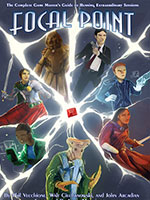
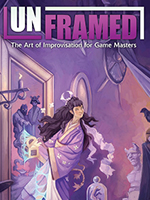

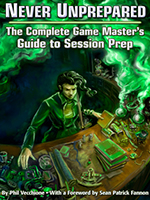
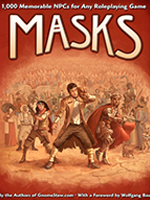
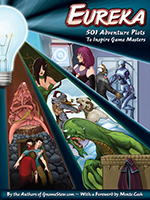


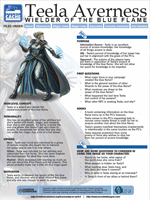
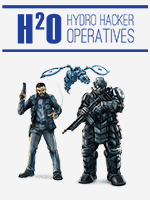
“the police can’t arrest you at a waffle house until you have finished your meal”
Police can’t enter hallowed ground, this tracks.
And I agree with all of this, Swords of the Serpentine is at the top of my list of games to play.
Thank you bro